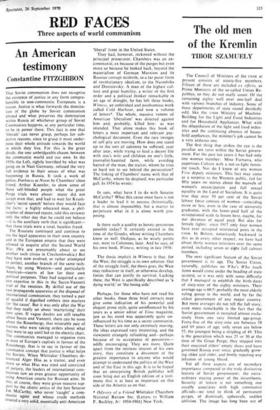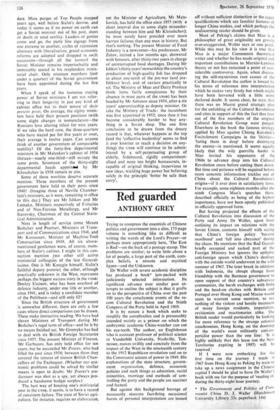The old men of the Kremlin
TIBOR SZAMUEI X The Council of Ministers of the USSR at present consists of ninety-five members. Fifteen of these are included ex officio, as Prime Ministers of the so-called Union Re- publics, so they do not really count. Of the remaining eighty well over one-half deal with various branches of industry. Some of these departments of state sound decidedly odd, like the USSR Ministry of Machine- Building for the Light and Food Industries and for Household Appliances. What with the dilapidation of the light and food indus- tries and the continuing absence of house- hold appliances, the minister's job cannot be a very arduous one.
The first thing that strikes the eye is the peculiar sex ratio within the Soviet govern- ment. For the past ten years it has had only one woman member: Mme Furtseva, who supervises Culture with a not-so-light femin-
ine touch. Nor do I know of any women First deputy ministers. This fact may come as a surprise to the Western public, fed for fifty years on stories about the marvels of women's emancipation and full sexual equality in the Land of Socialism. It is quite true that over 50 per cent of the Soviet labour force consists of women—coinciding more or less, even in the case of university graduates, with the lower-paid half of the occupational scale (a lesson here, maybe, for our devotees of equal pay). But alas for female rights: since 1917 only four women have ever occupied ministerial posts in the
USSR. In Britain, notoriously backward in this as in every other respect, we have had about thirty women ministers over the same period, including seven or eight full cabinet members.
The next significant feature of the Soviet government is its age. The Soviet Union, naturally. publishes no Who's Who (such items would come under the heading of state secrets), so it was only with some difficulty
that I managed to establish the birth-dates
of sixty-nine of the eighty ministers. Their average age is 60.5: probably the most elderly ruling group in the world, and by far the oldest government of any major country. But mere averages do not tell the full story; even more remarkable is the fact that the Soviet government is recruited almost exclu- sively from one very limited age-group.
Forty-five of the sixty-nine are between 58 and 69 years of age; only seven are below 55. the youngest being a stripling of 49. This is the generation which was 25 or 30 at the time of the Great Purge; they stepped into their executed elders' empty shoes and have governed Russia ever since, gradually grow- ing older and older, and firmly rejecting any infusion of young blood.
Yet all these aspects are of secondary importance compared to the truly distinctive feature of Soviet government: the extra- ordinary staying power of the incumbents. Security of tenure is not something one
usually associates with high communist officials—we tend to think of permanent purges, of dismissals, upheavals, sudden oblivion. The image has long been out of
date. Mass purges of Top People stopped years ago, well before Stalin's demise, and today it seems as if no power on earth can get a Soviet minister out of his post, short of death or total senility. Leaders of genius come and go, the party line zigzags from one extreme to another, cycles of repression alternate with liberalisation, grand economic reforms are adopted and dropped in swift succession—through all the turmoil the Soviet Minister remains imperturbably and immutably- seated in his resplendent minis- terial chair. Only nineteen members (just under a quarter) of the Soviet government have been appointed during the last five years.
When I speak of the immense staying power of Soviet ministers I am not refer- ring to their longevity in just any kind of cabinet office but to their tenure of their present posts. On average, the eighty minis- ters have held their present positions (with some slight changes in nomenclature—the Russians love altering titles) for nine years. If we take the hard core, the three-quarters who have stayed put for five years or over, their average is twelve years. Can anyone think of another government of comparable stability? Of the forty-five departmental ministers in Mr Malenkov's cabinet of 1954 thirteen—nearly one-third—still occupy the same posts. Seventeen of the thirty-eight departmental heads appointed by Mr Khrushchev in 1958 remain in situ.
Some of these worthies deserve separate mention. Three members of the present government have held to their posts since 1940! (Imagine three of Neville Chamber- lain's ministers, as it were, remaining in office to this day.) They are Mr Ishkov and Mr Lomako, Ministers respectively of Fisheries and of Non-Ferrous Metallurgy, and Mr Starovsky, Chairman of the Central Statis- tical Administration.
Next in length of service come Messrs Beshchev and Psurtsev, Ministers of Trans- port and of Communications since 1948, and Mr Kostousov, Minister of Machine-Tool Construction since 1949. All six above- mentioned gentlemen were, of course, mem- bers of Stalin's cabinet. I might in this con- nection mention two other still active ministerial colleagues of the late General- issimo. One is Mr Kosygin himself, Stalin's faithful deputy premier; the other, although practically unknown in the West, represents perhaps the biggest success story in the USSR: Dmitry Ustinov, who has been overlord of defence industry, under one title or another, since 1941, and is today a candidate member of the Politburo—and still only 62!
Since the British structure of government is somewhat different, there are only a few cases where direct comparisons can be drawn. These make instructive reading. We have had eleven Ministers of Transport during Mr Beshchev's regal term of office—and he is by no means finished yet. Mr Gromyko has had to deal with six British Foreign Secretaries since 1957. The present Minister of Finance, Mr Garbuzov, has only held office for ten years, but he succeeded Mr Zverev, who had filled the post since 1938; between them they covered the tenures of sixteen British Chan- cellors of the Exchequer. (Whether our eco- nomic problems could be solved by similar means is open to doubt: Mr Zverev's pre- decessor was shot as a spy, yet always pro- duced a handsome budget surplus.)
The best way of keeping one's ministerial post in the USSR, it seems, is to have a record of consistent failure. The state of Soviet agri- culture, for instance, requires no elaboration, yet the Minister of Agriculture, Mr Mats- kevich, has held the office since 1955 (with a short interval due to some slight misunder- standing between him and Mr Khrushchev); he must surely have presided over more harvest failures than any man in history. But that's nothing. The present Minister of Food Industry is a newcomer—his predecessor, Mr Zotov, retired a few months ago, showered with honours, after thirty-two years in charge of uninterrupted food shortages. During Mr Ishkov's thirty years' stewardship the country's production of high-quality fish has dropped to about one-tenth of the pre-war (and pre- Ishkov) level, and of caviare practically to nil. The Ministry of Meat and Dairy Produce (both items fairly conspicuous by their absence in most parts of the ussR) has been headed by Mr Antonov since 1954, after a six years' apprenticeship as deputy minister. Or take the Ministry of Trade: the incumbent was first appointed in 1952; since then it has become considerably harder to buy any- thing in a Soviet shop. The one firm conclusion to be drawn from the dreary record is that, whatever happens at the top (and the 'collective leadership' seems to find it ever knottier to reach a decision on any- thing) the USSR will continue to be admin- istered by a self-perpetuating group of elderly, hidebound, rigidly compartment- alised and none too bright bureaucrats, in- capable of original thinking, impervious to new ideas, wielding huge power but believing solely in the principle 'better be safe than sorry'.



































 Previous page
Previous page